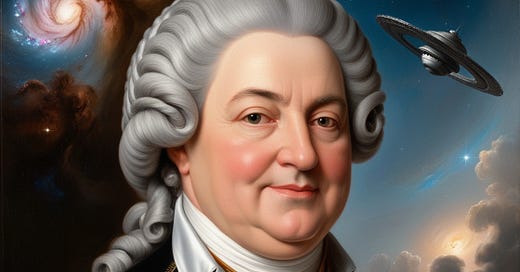Neapolitan Baroque: Extraordinary Interstellar Symphonies
"Alto Giove"— “Jupiter from above”: A Majestic Aria from Porpora's Polyphemus
The Neapolitan Baroque explodes with creativity, an unrepeatable season in which the art of sound reaches unique peaks of sophistication worldwide. The Neapolitan musical school dominated European courts, redrawing the boundaries of Western music through counterpoint, virtuosity, and passion.
The notes of "Alto Giove"—extracted from the opera Polyphemus by Nicola Antonio Porpora, Act III, Scene 5—burst forth like a liquid and infinite sonic universe. Porpora did not compose music; he created universes.
In the shadow of Handel
With a depth that transcends the boundaries of his time, even if distinguished in the Baroque music arena, his name remains in the shadow of Handel, that German composer who breathed the same Neapolitan musical atmospheres. Both frequented the same environments, absorbing influences that would later draw different artistic trajectories, with historical circumstances favouring Handel's fame.
Naples in the 18th century. Porpora shapes voices like a sculptural god, transforming young bodies into instruments of extreme beauty. His castrati are musical spaceships, vocal machines traversing impossible sound dimensions. Farinelli, his most famous student, becomes a legend: a voice that would make European courts tremble, existing at the borderline between human and divine.
"Alto Giove" is not an aria, but a cosmic narrative that surpasses temporal boundaries. Superimposing it on a nebula video, the music generates images: each modulation seems to give birth to stars, dilate gas clusters, and vibrate invisible particles.
"Alto Giove"— “Jupiter from above” - extracted from the opera Polyphemus by Nicola Antonio Porpora, Act III, Scene 5.
Interstellar
I would have wanted the majestic aria "Alto Giove" by Nicola Porpora to resonate in "Interstellar". I imagine the power of his vocality merging with the evocative cosmic images, creating an intense sensory experience. The emotionality of the piece, with its nuances of solemnity and spirituality, could have amplified Cooper's crucial journey scenes, making them even more touching. I particularly think of the wormhole crossing, the space-time tunnel connecting distant universe points.
The wormhole image in "Interstellar" is powerful: a vortex of distorted light and space representing a gateway to the unknown. In this context, the solemnity of "Alto Giove", with its almost divine vocality, could have underlined the transcendental scope of the event, transforming the passage through the wormhole into a spiritual journey, at the boundary between science and metaphysics. Porpora's aria could have given voice to the immeasurable mystery hidden behind that space-time breach, amplifying the sense of wonder and reverential awe permeating the scene.
Interstellar - Wormhole Scene (HDR - 4K - 5.1)
Porpora is not a minor composer, but an architect of sound universes who intuited what physics now confirms: every fragment contains the whole, and every vibration is potentially creative.
Nel suo profondo
I hope to soon read more details about the history of Neapolitan castrated singers in the book "La voce degli Dèi. Gli evirati cantori, e la Scuola vocale napoletana" - "The Voice of the Gods. The Castrati Singers and the Neapolitan Vocal School” by Enzo Amato.
I close my eyes. The music continues. Stars are born.
And Porpora, somewhere, smiles.
“Nel suo profondo vidi che s’interna, legato con amore in un volume, ciò che per l’universo si squaderna: sustanze e accidenti e lor costume quasi conflati insieme, per tal modo che ciò ch’i’ dico è un semplice lume. La forma universal di questo nodo credo ch’i’ vidi, perché più di largo, dicendo questo, mi sento ch’i’ godo.”
(Dante, Paradiso, XXXIII)
The performance heard in the video is from: Nicola Antonio Porpora, Polyphemus, extract: Act III, scene 5: Aria: 'Alto Giove' [Jupiter from above]. Performance by the Conservatoire national supérieur de musique et de danse de Paris under the direction of Pascal Duc; with Victoire Bunel (soprano), Tania-Lio Faucon-Cohen and Ajay Ranganathan (altos), and other musicians (see source for complete list). From M. Hobson (ed.), Denis Diderot's 'Rameau's Nephew': A Multi-media Bilingual Edition. Cambridge, UK: Open Book Publishers, 2016. DOI: 10.11647/OBP.0044.17. License: Creative Commons Attribution 4.0 International (CC BY 4.0).
Feel free to leave a comment.
I have woven tales for anyone who cares to read them. My books await you on Google Books. Check also my stories on Medium.com.
I am eager to participate in research and produce content on Cross-Cultural Philosophy. Considering the many philosophy professors following Learn Vedanta Substack from universities across the five continents, I would be truly honoured to be involved in projects, as I have been recently approached. Please feel free to contact me.
I would be honoured if you considered subscribing to the Premium Contents of my Vedanta Substack and leaving feedback, comments, and suggestions on this page and by writing to me at cosmicdancerpodcast@gmail.com.
GIFT A LEARN VEDANTA SUBSTACK SUBSCRIPTION.
Thanks for reading.




